The number of homeless youth in the U.S. has reached an all-time high and this represents a growing social problem. Research indicates that homeless youth are significantly at-risk for experiencing a range of negative life-outcomes such as school dropout, the development of mental health problems, use/abuse of illicit substances, suicidality, and even early mortality. Thus, effective interventions and mental health supports are needed to help address their complex mental health needs. Fortunately, however, many homeless youth regularly attend school, especially younger youth (i.e., under 13 years old) and youth who are members of homeless families. Therefore, as important members of school communities, school-based mental health professionals can help support these students. With this aim in mind, this paper discusses the use of a Multi-Tiered System of Support (MTSS) framework to meet the mental health needs of homeless students in schools. More specifically, following a public health service delivery model, service delivery is discussed at universal, selective, and indicated levels. Lastly, to address the diverse needs of homeless students, integrated service-delivery across various systems of care is discussed.
According to a report by the U.S. Department of Education, a record number of homeless students—1.1 million—are now enrolled in public schools (National Association for the Education of Homeless Children and Youth [NAEHCY], 2014). Moreover, according to the same report, rates of homeless students have increased 72% since the beginning of the 2008 economic recession and approximately 10% since the beginning of the 2011–2012 school year. Collectively, these findings indicate that student homelessness is a growing problem in the U.S.
Student homelessness is a major social problem that impacts society as a whole. Experiencing episodes of homelessness in childhood is associated with being homeless in adulthood as well as with being socially maladjusted and economically disadvantaged (Simons & Whitbeck, 1991). One study that was conducted with homeless individuals (N = 10,193) in the greater Los Angeles area found that the typical cost for services for each homeless individual was approximately $35,000 per year ( Flaming, Matsunaga, & Burns, 2009). However, homeless individuals with mental health problems are even more costly to society. A study that included homeless individuals with mental health problems (N = 4679) in New York City found that it cost taxpayers an average of $57,561 (inflation adjusted) per person per year in services to support each homeless individual ( Culhane, Metraux, & Hadley, 2002). Thus, although the exact cost of each homeless individual to society is not known, estimates obtained from major metropolitan regions suggest that this cost is substantial.
Because student homelessness is a significant problem that exerts a considerable burden on affected individuals and society, effective assessment and intervention practices are needed to help mitigate this problem and help those who are in need of support. Furthermore, because student homelessness is a complicated phenomenon that includes different subtypes of homeless youth (e.g., situational runaways, throwaways, systems-youths) that display different needs (Milburn et al., 2009), integrated and comprehensive assessment and intervention practices are needed to help address this problem. With this aim in mind, this paper discusses the use of a Multi-Tiered System of Support (MTSS) framework to meet the mental health needs of homeless students in schools that often go unrecognized and untreated. Consistent with this aim, service-delivery practices are discussed at universal, selective, and indicated levels following a public health service delivery model.
The number of homeless youth in America is a growing problem with significant implications. First, the notable increase in homeless youth in this country speaks to a number of unfortunate realities of our time, including economic decline, family estrangement, a grossly insufficient health care infrastructure, high rates of substance abuse, and of course, mental health treatment needs outpacing our capacity to serve those in need, especially among children and adolescents. Because being homeless at a young age portends dire outcomes and prognoses across most health variables, an effective response to this problem is needed.
Efforts to serve homeless students through MTSS might help a substantial number of these youth. Even if the problems contributing to their distress cannot be eradicated, the provision of more relief and support to homeless students—regardless of the amount—may make a meaningful difference in these students' lives (Jozefowicz-Simbeni & Israel, 2006). Instead of feeling overwhelmed from the prospect of serving a highly at-risk population that often experiences negative life outcomes, school-based mental health professionals should feel empowered by their effort to make a difference. Homeless students need all the support they can get and school-based mental health providers are well-positioned to meet the mental health needs of homeless students through using MTSS and through utilizing critical laws that govern school-based service delivery.


